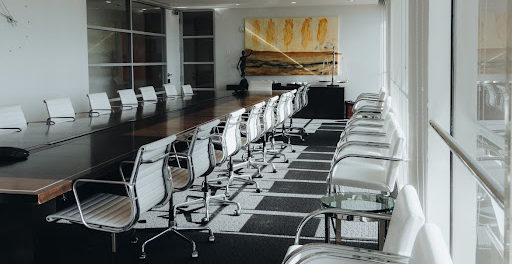
If you are hosting a meeting, one of the most important considerations is the meeting room layout. The optimum meeting room layout will help everybody see the whiteboard or other meeting materials and hear the speakers. It will also help anyone who is joining the meeting virtually, experience it as if they were there.
In this article, we will look at several meeting room layouts and examine which is best for certain types of meeting.
A conference room layout is the set up of chairs and tables in a conference space. The most effective conference room layout depends on the size and style of the meeting.
Boardroom style is one of the most popular meeting room styles - and you’ve probably seen it before in many office-related movies.
It consists of a small group of people sitting around a large table. An interactive whiteboard or alternative, like those sold at Avocor, could be installed on any of the walls. Any virtual participants could join in on the interactive display.
This boardroom style meeting may be led by one or two people, but typically everybody in the meeting will participate.
This is a really effective way to run a meeting if you want active involvement from everybody.
U Shape Style is another popular meeting room design for smaller discussions. It involves a small group of people sitting around tables in a U shape or horseshoe formation.
The speaker will stand at the open end of the U shape, and they can give a presentation here. They could install an interactive display on the wall by the top of the U shape.
Because people usually have a table with lots of space, this style is excellent for taking down notes. It can be used for formal meetings or informal collaborative office spaces.
Although the speaker traditionally stands at the top, the U shape means that all participants face each other and can easily enter into a discussion.
This type of meeting room is excellent for companies with remote workers, as they can join the meeting virtually via the interactive display.
A box style meeting set up is a U shape with another table running along the side, creating a box or a hollow square. The meeting leader will stand in the middle and lecture a small group from there.
This isn’t the best meeting room layout for presentations, as the participants will all be facing away from a wall - so there is nowhere to mount an interactive display.
However, a box style layout works well for meetings with breakout sessions, where smaller groups of meeting participants can discuss certain aspects before returning to the main forum.
This meeting room setup is usually for much larger meetings and conferences. It consists of rows of people facing the front as they would in a theatre or university lecture hall.
The speaker will stand at the front of the hall with their interactive display. People in the company may not contribute directly to the meeting, although they may ask some questions at the end.
People could join this meeting virtually if it is live streamed.
Like in a wedding or other event, a banquet style meeting features several large round tables with participants sitting on chairs surrounding them.
This type of meeting is often casual and especially good for networking events, as participants are likely to chat to the others at their table. A banquet style meeting could even (as the name suggests) involve food and drink!
There may be a speaker, panel or display at the front, but the meeting will probably mainly consist of networking with people at the table.
Like the banquet style, this meeting room plan consists of groups of people sitting on round tables.
The main difference between banquet and cabaret style is that participants will usually sit at the back of the table and watch a presentation or speaker at the front.
This type of meeting is typically more formal than banquet style - it may be more focused on the speaker or panel and less on the table participants - but less formal than lecture style.
It normally consists of a lecture and Q&A session after.
For very casual meetings, standing might be an option. This style is typically for huddle rooms or other meetings that won’t last too long.
They might be more informal meetings that don’t require any kind of presentation or display between members of staff who know each other well.
Classroom style is basically lecture style, but with tables. Meeting participants all have tables in front of them to take notes or place other items. The speaker will stand at the front where they might do a presentation.
This style is perfect for larger meetings where participants need to write things down or discuss various points in groups.
Presentation style meetings are usually larger meetings with an interactive display at the front and rows of people facing the presentation. However, if you are presenting in a smaller meeting, you might use the boardroom or U shape style, ensuring that everybody can easily see the interactive display.
Here are a few tips for arranging your meeting room:
From U shape to lecture style, there are many different meeting room arrangements. The perfect layout depends mainly on the number of people at the meeting, the room size, how formal it is and what is being discussed. Every meeting is different, and one company may use several meeting room styles!
The tips and descriptions above should help you decide which meeting room style is best for you.
Keep up to date with all the latest from Avocor and partners and get information on upcoming events and exciting product news.
Speak to one of our product specialists and find the perfect solution for you.